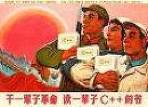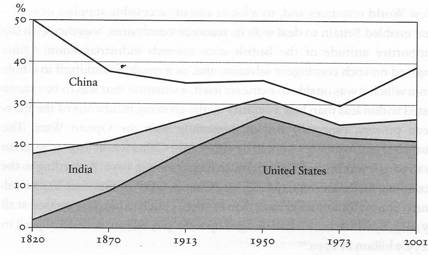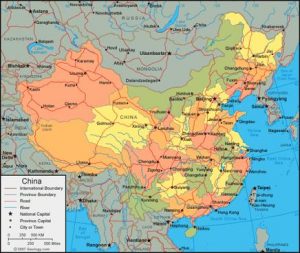An eminent historian looks at the U.S.-China relationship and sees many possibilities for success and failure for the United States in coming to grips with the rise of China. Indeed, this intensely complex and multifaceted relationship appears to become ever complicated to manage for both parties.—The Editor
by Michael H. Hunt
The media provides almost daily reminders of how complex and tangled the U.S.-China relationship has become. The range of issues in play is extraordinary, even unprecedented. At the forefront right now are a mix of hardy perennials (such as arms sales to Taiwan, the future of Tibet, and human rights) and newly emergent concerns (such as internet censorship and cyber warfare, sanctions against Iran and North Korea, holdings of U.S. debt, the trade gap, currency devaluation, competition over oil and other natural resources, and the response to climate change). Taken together, these issues generate considerable contention and have the potential over time to spawn a dangerous level of ill will.
Viewed in historical perspective, the U.S.-China relationship may now be at a major inflection point. On the one side, an increasingly strong and self-confident China poses a profound challenge to a U.S.-defined and dominated global regime. On the other side, American elites continue to have a hard time coming to terms with this unfolding challenge. While U.S. presidents have grudgingly accepted China’s legitimacy as a major power, rumblings of discontent with China’s Communist Party dating back some six decades have echoed powerfully in Washington and the media. The result has been a divided U.S. response to China’s rise, part accommodation, part confrontation, and each arising from distinct, even contradictory premises.
Let’s start with the nature of the China challenge. Its foundation is, above all else, a half century of successful economic development. What tends to get lost amidst the daily reports of booming output, changing skylines, and mushrooming consumerism is the origins and long-term significance of this success. However painful for Americans to accept, it is the product of a strategy shaped and supported by the Chinese Communist Party.

|
| Chinese Posters |
After a more than a century of economic stagnation in which per capita GDP did not increase, Communist victory in 1949 heralded a distinct upturn in material conditions for ordinary Chinese. Income doubled between 1950 and 1973 thanks to the new and powerful party-state.1 It promoted industrialization, invested in infrastructure, set limits on urbanization, secured political order, and maintained security along a vast and vulnerable frontier. To be sure, party control led to costly experiments and colossal errors, most notably the twenty million or more lives lost as a result of the Great Leap Forward campaign of the late 1950s. But the economic and political achievements during the Mao Zedong years were considerable and indispensable to the mounting of the China challenge.

Those achievements made it possible for Deng Xiaoping to move quickly on economic reform in the late 1970s and secure remarkably rapid results. While he preferred to describe his program as “socialism with Chinese characteristics,” it would be more accurate to call the new course a variant on a proven Asian-style model of economic development. The state-guided capitalism pioneered by Japan and widely adopted in the region assigned a major role to free markets; it gave the state an important part in guiding those markets; and it put a high priority on production of export goods. The results in Deng’s China as elsewhere in eastern Asia were stunning. Between 1973 and 2001, the per capita GDP more than quadrupled. The growth has continued at a similarly robust pace over the last decade.
What is seldom noted but should be troubling for American observers is the international significance of this economic success. To begin with, China’s record has become the envy of the developing world. There generally post-colonial economies have not performed well, and in some places in recent decades they have virtually flat lined. China’s case argues for having the state make the strategic choices critical to social stability, social welfare, and economic progress. China has emerged the poster child for an anti-liberal development model. It is one distinctly at odds with the U.S. bias toward giving maximum play to the hidden hand of the market.
China’s economic success is also reconfiguring the global economic system in a way that is undermining a century and a half of global dominance by the North Atlantic economies. By the middle decades of the twentieth century the United States and Western Europe had come to account for over half of global output. China’s position had by then fallen to 5 percent, down from its preeminent place in the early nineteenth century when it accounted for fully one third of the world’s total. By 2001 China had thanks to rapid growth regained some lost ground. It could claim 12 percent of world output and together with the other two major Asian powers (Japan and India) was mounting a challenge to the global dominance of the North Atlantic economies. Anyone with a tendency toward a materialist view of historical potential will recognize the enormous implications that China’s economic achievements carry for the way the global economy will work and for the way global power will be redistributed. One recent study overstates matters in a title that has China ruling the world and ending Western dominance — but not by much.2
 |
| Changing shares of global output: The return of China and India and the relative U.S. decline3 |
Behind China’s economic drive is nationalism comparable in its depth and potency to that entertained by Americans. Giving energy to this nationalist faith are the inspiring images of China’s civilizational glory going back millennia and the shaming reminders of humiliations inflicted by the major powers from the early nineteenth century well into the twentieth. This may be unknown or irrelevant history for most Americans; it is a living past for politically engaged Chinese today no less than a century ago. This memory of glory won and lost has provided the emotional fuel for measures to boost China’s international standing, for resentment against U.S. criticism, and for resistance to any hints at outside intervention or intimidation. These persistent nationalist preoccupations have quickly bubbled to the surface at times of crisis (as, for example, in this poem written by a student in 1999 amidst the furor over the U.S. bombing of the Chinese embassy in Belgrade):
1.2 billion people shout together:
The Chinese race will not be insulted!
The giant dragon has woken to take off in the Orient,
How can your kind of paper tiger resist?4
One of the prime articles of China’s nationalism is a belief in the importance of a strong state to generating the “wealth and power” essential to restoring sovereignty, territorial security, and above all pride. The Communist Party was by no means alone among the contenders for power in its almost instinctive reliance on state power to achieve a well-regulated, secure socio-economic order. But it alone was able to turn the trick. Mao and then Deng defined the particular form and direction of state building that has made the China challenge possible. As in other instances of successful nationalist projects, the Chinese state is the culmination of nationalist dreams and in turn has served as a vehicle for national education and mobilization.
The other nationalist article of faith important to China’s now restored standing is a tenacious commitment to preserving what is in effect the last major surviving continental empire. Communist power holders have done what their Nationalist rivals would also have done had their long rivalry turned out differently. Since 1949, Beijing has set about maintaining or recovering the territory covered by the high tide of expansion during the last dynasty in the late eighteenth century. This imperial project puts China in a pivotal place in the affairs of Asia — from deep into region’s interior core out to the now dynamic maritime zone. To be sure, having a vast multinational empire carries costs. It creates irredentist movements (notably in Tibet and Xinjiang); it perpetuates a stubborn dispute over Taiwan; it spawns friction with neighbors over a motley assortment of islets; and it creates potential for confrontation over a long and murky border with India, Russia, Vietnam, and Burma. With their pride in the central position of the new Middle Kingdom, Chinese nationalists seem ready to pay the price.
The return of China to a place of power and pride has evoked a distinctly paternalistic U.S. response with roots in an earlier era. By the beginning of the twentieth century, Americans had come to imagine themselves patrons and protectors of a weak, poor, divided China. Their impulse to guide and transform found prominent expression in the missionary commitment to help modernize the country and in Washington’s support against a sustained Japanese drive to subjugate China. What few Americans noticed at the time was the hostile nationalist reaction against their putative patron. Already at the opening of the twentieth century, Chinese observers were making Americans into imperialists just like all the others. By the 1920s a consensus had emerged across the political spectrum that Meiguo (literally “the beautiful country”) had turned into something sinister, Meidi (or “U.S. imperialism”). The resentment over foreign domination came sharply and effectively to the fore when Communist forces triumphed in 1949. The United States as the dominant postwar power with broad ambitions in eastern Asia quickly emerged as the main target of the Chinese revolution.

The victory of Mao’s Communists at the expense of the U.S.-backed Nationalists of Chiang Kai-shek was a bitter pill. Washington decided to refuse to swallow it — to reject the legitimacy of the Chinese state and to hope that the Communists would simply go away. How could the Beijing regime survive? It was a Soviet imposition, and eventually the Chinese people would send it packing. To hasten that happy day, U.S. policymakers sought to contain and isolate China. At two points along China’s border — Korea and Vietnam — this approach plunged U.S. forces into conflicts that Americans were not (as it turned out) prepared to sustain. Mao, who seemed to relish the chance to “beat American arrogance,” checked the Truman administration’s attempt to unify Korea, confronted the Eisenhower administration over the future of Taiwan (where Chiang’s Nationalists were holding on), and provided assistance essential to the Vietnamese Communist victory over the French and later the Americans.
Two decades of fruitless denial and unwanted conflict finally undermined an outdated, stultifying, and self-defeating U.S. response to a rising Asian power. Richard Nixon’s name is properly associated with a dramatic shift from paternalism toward accommodation. Nixon had learned over a political career going back to the “loss of China” in the late 1940s that Washington lacked the means or the will to reverse China’s achievements or to negate its aspirations. China was a de facto regional power that the U.S. ignored at its own peril. He arrived in the White House in 1969 ready to engage in serious talks for the first time since 1949, and his trip to China in early 1972 marked the success of his initiative.
Even as Nixon’s policy of practical accommodation took hold, murmurs of discontent could be heard from some American opinion leaders. Steeped in the old paternalism, they found compounding with totalitarians distasteful. Those murmurs turned into a broad-based, vociferous denunciation following the suppression of the 1989 demonstrations in Beijing. From Congress, think tanks, and the media came arguments that still featured the Chinese people as wards and the Communist leaders as reprehensible butchers or a collection of fossils obstructing their country’s “natural” development in the direction of U.S. institutions and values. The critics recycled the well-worn view that a regime so morally wrong — “repressive and bloodstained” as the editors of the Washington Post put it — could not survive.5 They imagined that an internal crisis or popular pressure was bound sooner or later to bring the Communist regime down or that economic liberalization would ultimately break the Communists’ iron grip on political power. Washington should, so the critics contended, challenge the Communists on every front from Taiwan to Tibet to pro-democracy activism. These well-worn criticisms were given wide currency by journalists whose accounts offered the most elaborate, widely read treatment of China’s political flaws and the limits of the “soft” Nixon policy.6
The duel between Nixon’s emphasis on accommodation and the critics’ insistence on confrontation has made U.S. China policy fundamentally contradictory. Virtually all Nixon’s successors in the White House have accepted the logic of his realpolitik course. They valued China as an ally against the Soviet Union late in the Cold War. They have wanted to assure American corporations access to a market of increasing importance. And they have more and more needed Beijing’s cooperation on regional and even global issues of common interest. But so politically potent were the cries of the critics that presidential candidates have had to indulge a bit of China bashing whether they believed what they said or not. And once in the White House they have engaged in a straddle. Even as they followed the essentials of the Nixon policy, they continued substantial military aid to Taiwan, lent verbal support to the cause of Tibet, publicly invoked timeworn clichés about the needs of the Chinese people, and offered assurances about inevitable liberalization. “The genie of freedom will not go back into the bottle,” so Bill Clinton optimistically opined.7 This confidence in the power of more open markets and access to the internet to break the grip of the Communist Party had the great virtue of appeasing critics while justifying continued engagement with a defective regime.
The abiding ambivalence over how to respond to a rising regional power with an impressive track record of success and a clear conception of its place in the world is still strikingly in evidence. President Barack Obama gestured in the direction of those wanting to change China in his comments late last year before a Shanghai audience. While disclaiming any intention of forcing political change on China, he asserted that the United States stood for values of universal applications — and would press them on others. He had in mind “freedoms of expression and worship — of access to information and political participation” as rights that “should be available to all people, including ethnic and religious minorities.”8 To make plausible the prospect of a China transformed along these lines, the president retailed a fairytale version of U.S.-China relations. His history of imagined amity and goodwill suggested that two countries would work their way toward a meeting of the minds (on whose terms the president did not need to say.)
But Obama is also learning to appreciate the alternative realpolitik approach. It facilitates working with Beijing to address issues of common interest. Adding to the appeal of accommodation is the steadily weakening U.S. position in the world. While the Chinese national project is prospering, the fundamentals are now more against the United States than they were in 1972 when Nixon began to face reality, not to mention the glory days of U.S. global dominance in the 1940s and 1950s when the confrontation with China began.9 The unipolar moment is long past. Commitments that are straining U.S. resources have become even harder to manage in the wake of the recent economic crisis with its high social costs and the accompanying intensification of domestic political polarization. Given the importance of shoring up the domestic foundations on which the U.S. status as a great power was built and continues to depend, empty if offensive declarations about how China must change make little sense even if they give some Americans a good feeling.
The future of the relationship may depend ultimately on the attitudes of political elites. In both China and the United States, they are in thrall to a deeply rooted sense of national identity and by extension of how to deal with the other. The difference is that Chinese nationalists can celebrate success and dismiss American criticism with impatient rejoinders about how the once mighty need to deal with their relative decline with better grace. American nationalists, on the other hand, will find invocation of universal principles an empty, even counterproductive exercise. But to admit U.S. limits in relation to China is to set in question broader claims to global leadership and all the mystical hocus-pocus about providence and destiny that has come to be associated with the idea of the American Century. It is easy to imagine difficult if not dangerous times ahead between these two headstrong powers.
This essay is based on a lecture for the UNC Great Decisions series on 23 February 2010.My thanks to Andrea Hubert and James Ding for the invitation to do the lecture and for the pleasure of preparing it in collaboration with them.![]()
Endnotes
1. Per capita GDP and relative GDP data in this and the following paragraphs come from the master of national accounting, Angus Maddison in The World Economy: Historical Statistics (Paris: OECD, 2003), 30, 262.
2. Don’t be put off by the sensational title of Martin Jacques, When China Rules the World: The Rise of the Middle Kingdom and the End of the Western World (London: Allen Lane, 2009). It is a timely, astute, and accessible treatment of the changes that China has undergone and the consequences for the United States and the international system. The author brings to his topic a combination of regional expertise and broad historical perspective generally missing in journalistic appraisals.
3. Graph from Jacques, When China Rules the World, 30 (drawing on Maddison, The World Economy: Historical Statistics, 30).
4. Poem from Peter H. Gries, China’s New Nationalism: Pride, Politics, and Diplomacy (Berkeley: University of California Press, 2004), 106. “Paper tiger” was a dismissive term applied to the United States during the Mao era.
5. Quoted phrase from James Mann, About Face: A History of America’s Curious Relationship with China, from Nixon to Clinton (New York: Alfred A. Knopf, 1999), 223.
6. For two notable critiques by journalists, see James Mann, The China Fantasy: How Our Leaders Explain away Chinese Repression (New York: Viking, 2007), and Richard Bernstein and Ross H. Munro, The Coming Conflict with China (New York: Knopf, 1997), digested in “The Coming Conflict with China,” Foreign Affairs 76 (March-April 1997).
7. Clinton remarks at the Nitze School of Advanced International Studies, Washington, D.C., 8 March 2000, in Public Papers of the Presidents of the United States: William J. Clinton, 2000-2001, book 1 (Washington: U.S. Government Printing Office, 2001), p. 407.
8. Obama speech at a 16 November 2009 Shanghai town hall meeting: http://www.whitehouse.gov/the-press-office/remarks-president-barack-obama-town-hall-meeting-with-future-chinese-leaders(accessed 31 January 2010). 9. The case for a fundamentally weakened U.S. global position can be found in my The American Ascendancy: How the United States Gained and Wielded Global Dominance (Chapel Hill: University of North Carolina Press, 2007), chaps. 7, 8, and Conclusion.
 Michael Hunt is the Everett H. Emerson professor emeritus at the University of North Carolina at Chapel Hill. Now a free-lance historian, he maintains broad and varied interest in U.S. foreign relations and international/global history including an active program of research and writing. His most recent book is The American Ascendancy: How the United States Gained and Wielded Global Dominance.
Michael Hunt is the Everett H. Emerson professor emeritus at the University of North Carolina at Chapel Hill. Now a free-lance historian, he maintains broad and varied interest in U.S. foreign relations and international/global history including an active program of research and writing. His most recent book is The American Ascendancy: How the United States Gained and Wielded Global Dominance.
